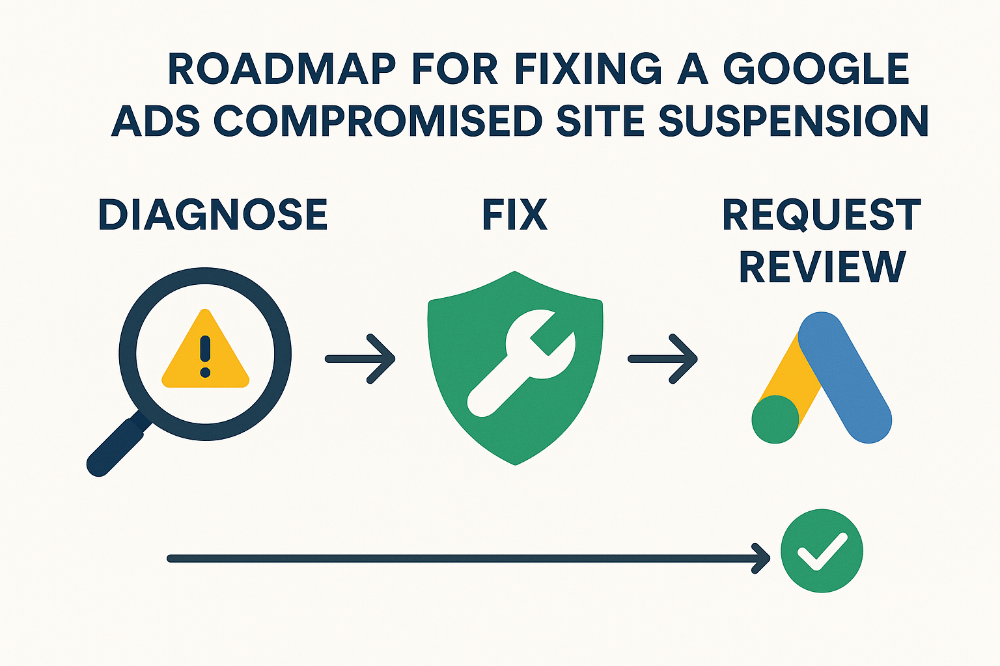Recover Fast from a Google Ads Compromised Site Suspension
When Google Ads flags your site as compromised, everything comes to a halt. Campaigns stop running, impressions drop, and customers can’t reach you.
The frustrating part is that it often happens without warning.
A compromised site in Google’s eyes usually means your website has been hacked or injected with harmful code, which violates their compromised site policy. It might be malware, phishing pages, or sneaky redirects that you didn’t even know existed.
Losing traffic and ad revenue because of this can feel overwhelming. But recovery is possible.
In this guide, we’ll walk through a fast, clear plan to identify the issue, clean up your website, and take the right steps to get your ads reinstated. And with cybercrime projected to cost businesses over $10.5 trillion by 2025, speed isn’t optional, it’s critical.
Related: So What Exactly Is a Compromised Site
Common Signs Your Site is Flagged
The first clue usually comes when your ads get disapproved without much detail. If you check the account, you may see a message about a hacked site in Google Ads or warnings tied to suspicious activity.
Another clear sign is inside Google Search Console. Under Security Issues, Google often lists problems like “malware detected” or “phishing content found.” These alerts may feel technical, but in plain terms, it means your site is hosting harmful files that could put users at risk.
Sometimes, the warning is even more obvious. A visitor might land on your page and see a bright red website malware warning from Google Safe Browsing. And given that, in 2024, there were over 600 million cyberattacks every single day, spotting these signs quickly can save you from deeper losses.
The sooner you catch these signals, the less money you lose on wasted ad spend. Knowing how to act quickly can mean the difference between a short pause and a long suspension.
See also: The Impact of a Compromised Site on Your Google Account
Quick Recovery Steps (What to Do Immediately)
When your account is suspended for a compromised site, speed matters. Every hour your ads are down means lost revenue.
The good news is there’s a clear path to recovery if you follow the right order of steps.
Step 1: Verify the Issue
Start by confirming what Google sees. Open Google Search Console and check the Security Issues report. You can also run your site through Google’s Transparency Report tool. Both will show whether malware, phishing pages, or suspicious redirects are flagged.
Step 2: Clean the Site
Once confirmed, move straight into website malware cleanup. Tools like Sucuri or Wordfence (for WordPress) can scan your files and highlight infected code. If you’re not technical, this is the moment to bring in a professional who knows how to dig out hidden backdoors and database injections.
Step 3: Secure Everything
Cleaning is only half the job. You need to close the doors that let attackers in. Update all plugins, themes, and core software. Add two-factor authentication for wp-admin, and consider a web application firewall (WAF) like Cloudflare. This step helps stop reinfections, which are a common reason Google keeps ads suspended.
Step 4: Request Reviews
After cleanup and security checks, go back into the Search Console and file a Security Issues Request Review. Be clear in your notes about what was fixed. At the same time, log into your Ads account and request a manual review in Google Ads for the disapproved ads.
Pro tip: When appealing, add a short, honest explanation of what went wrong, how you fixed it, and what measures you’ve taken to prevent it from happening again. Google’s review teams appreciate clarity.
Following this order helps you move faster and reduces the chance of missing something important.
For businesses that want outside help, Jupp Lee also offers dedicated Google Ads Compromised Site Support to guide the process from start to finish.
Why Ads Stay Disapproved After Cleanup
It can be frustrating when you’ve cleaned your site but your ads are still blocked.
A common reason is cached malware.
Even if the files are gone, browsers or CDNs may be serving old, infected versions of your pages.
Another overlooked issue is hidden backdoors.
Attackers often leave scripts or database entries that reinstall malware after cleanup. If these are not removed, Google may keep marking your account under the disapproved compromised site category.
The solution is to double-scan your site, clear hosting and CDN caches, and make sure every trace of malicious code is removed.
Once you are confident the site is safe, re-request a manual review in Google Ads. Adding a clear explanation of what was fixed increases the chance to reinstate Google Ads quickly.
Prevent Future Suspensions
Fixing your site is only half the job.
The real win comes from preventing the problem from happening again. When Google suspends ads for a compromised site, it’s often because weak spots were left open. Closing those gaps keeps your account safe and helps you avoid another scramble to reinstate Google Ads.
Start with the basics. Keep all plugins, themes, and core software updated. Run regular scans so hidden threats don’t pile up unnoticed. Schedule automatic backups so you can restore a clean version if something slips through.
Next, add stronger security layers. Use 2FA for wp-admin so attackers can’t break in with stolen passwords. A firewall for your website, such as Cloudflare WAF, can block suspicious traffic before it reaches your server. Together, these steps make it much harder for hackers to compromise your site again.
Long term, investing in prevention is far cheaper than dealing with repeated suspensions. You protect your ad spend, your brand reputation, and your peace of mind. For more guidance, see Jupp Lee’s advice on avoiding Google Ads suspensions.
FAQs
1. Why did Google suspend my ads for a compromised site?
Google flags ads if your site hosts malware, phishing content, or unsafe redirects. Even if you didn’t cause it, your account gets paused until the issue is fixed.
2. How long does it take to reinstate ads after cleanup?
If the cleanup is thorough and you submit a clear review request, ads can return within a few days. Complex cases may take longer, especially if hidden code remains.
3. Can I prevent future compromised site suspensions?
Yes, regular scans, backups, 2FA for wp-admin, and a strong firewall lower the risk and keep your campaigns running safely.
Final Thoughts
Recovering from a Google Ads compromised site suspension is all about speed and order. Verify the problem, clean your site, secure it, and file the right reviews. Acting quickly reduces downtime and protects your ad spend.
If you need expert help, Jupp Lee offers a full guide on Google Ads Suspended to get you back on track faster.


































